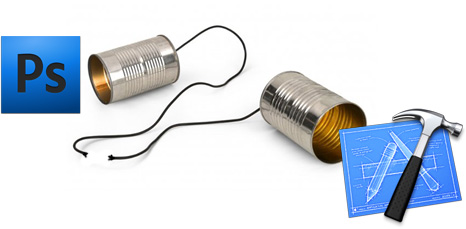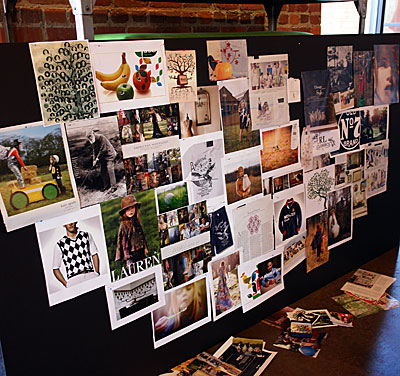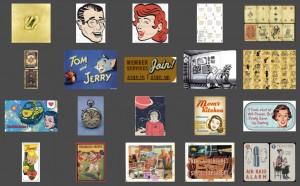
Coders often find it difficult to relate to designers, much less collaborate and communicate with them in a productive — and enjoyable! — way. If you’re already working with a designer, these tips can help you better understand them; if you’re looking for a designer, this could help you find a competent one.
Know what you want
This isn’t 100% necessary, but it will usually help save you money in the long run. Going through this post and preparing what needs to be done before even approaching a designer will show your professionalism and respect for their craft. This could help you snag a great designer rather than just a good one.
Being decisive also falls under this category. Flip-flopping on design decisions can be frustrating for the one redoing that button for the nth time. Sometimes it’s hard to know what you want until you see it, but that’s why you should…
Find reference material

I like to build a Mood Board for new projects. A Mood Board is a collection of materials that reflect the feeling – or mood – of the look you want. Start saving images or taking screenshots of ANYTHING that you like the style of; fonts, lighting, art style, textures, costumes, colour schemes, etc. To organize them, add notes describing what you like about them and how you see it fitting into your overall vision. It could also be beneficial to organize them into folders: backgrounds, characters, objects, logos, etc.
For example, you might say, “I like the wardrobe from Sin City, but I really like the art style from Knight’s Rush. And I liked how in Traffic all the scenes with Douglas were tinted blue and all the scenes with del Toro were tinted yellow… maybe we could do something like that for the two worlds in my game.”
Here’s some images from a mood board I created for Face Race:
This may seem like a lot of work, but you don’t have to be super detailed, and having a folder on your desktop that you can drag images to as you go about your day isn’t that difficult. You’d be amazed at how much this can help your designer realize the vision you have in your head. The alternative is paying your designer to come up with a mood board and develop the visual theme for the game from scratch. Some may prefer this, but expect it to cost a lot more.
Here’s a great little post on Finding a look / feel for your game by @letsbrock.
Be clear and constructive
Designers can be touchy about their designs, and can easily get emotionally attached to a concept or idea that you’re not as excited about as they are. Designers who can handle iterations — and even big changes — well are gems, hang on to them. But giving solid feedback is a huge plus on your end. Saying, “It’s just not quite there yet… but I can’t put my finger on why,” while often true, is one of the most frustrating things a designer can hear.
Try to pinpoint what it is you like or don’t like about a specific design element. Again, if you can’t put it into words, it helps to find reference material that shows more of what your going for. “I like the shape of what you’ve got here, but maybe the colour tones could be more like the ones in this JPG, and the lines could be bolder and more cartoony… What do you think?”
Know what you need and be detailed
Don’t be afraid to get technical. If your designer has worked on games before, they’ll know what parralax backrounds and sprite sheets are. Tiling, variations on a sprite, whether or not the highlight graphic is overlaid on top or replaces the original sprite, how many animation cycles you need, etc. The technical details of how the graphics are actually used by the code really help a designer understand the requirements of the project.
Understand that in your conversations with any good designer, what you need (or the best way to do things, graphically) may change. Make sure the scope of the design project doesn’t escalate, or make sure your designer is properly compensated for the extra time if it does.
Set clear deadline expectations
 Make sure your designer knows all important milestones that need to be met, and which ones are the priority (eg. Which ones other people are depending on, etc) and which ones can slide a bit. If the scope is starting to shift (as described above), bring it up again and make sure it’s still doable, or adjust as necessary.
Make sure your designer knows all important milestones that need to be met, and which ones are the priority (eg. Which ones other people are depending on, etc) and which ones can slide a bit. If the scope is starting to shift (as described above), bring it up again and make sure it’s still doable, or adjust as necessary.
If your designer is increasing project scope through new design ideas, you can rein this in with: “That’s a cool idea, but we need to stay on track for this release. I’ll put it on the list of things to consider for the next release.”
If your designer is on contract and not working for you full time, chances are they have other ongoing projects. Make sure you have a really clear conversation with them about what their availability is, and if you need them to be working on your project exclusively for a fixed time, make sure you schedule this well in advance so that they can plan for it – or expect to pay more for them to rearrange their schedule.
Explain functionality
 I find it extremely beneficial to know as much detail as possible about how an object works in-game. This includes how it moves, what it does, how it affects other objects, why a player would want to use it, etc. Being able to play with a working prototype is ideal here, video is the next best thing. Creating an icon with a clear visual metaphor for an object or power-up, for example, is impossible without knowing these kinds of details.
I find it extremely beneficial to know as much detail as possible about how an object works in-game. This includes how it moves, what it does, how it affects other objects, why a player would want to use it, etc. Being able to play with a working prototype is ideal here, video is the next best thing. Creating an icon with a clear visual metaphor for an object or power-up, for example, is impossible without knowing these kinds of details.
Expect game design feedback

We’re designers. We like making things look cool. Expect to hear things like, “You know… if you did it this way, you could have this thing come sliding out the side, and a bunch of sparks go flying and this other thing goes shooting out of the front of it, and all this other stuff goes flying in the opposite direction, and the player gets a huge bonus, and…”
Personally I’m a game designer at heart, so giving game design feedback comes with the territory. Make it clear that feedback is welcomed, but not everything can or will be implemented. A good designer already knows this.
Trust us
This can take time if you just started working with a new designer, but try not to micro-manage small design decisions. If you need clarification about why your designer did something a certain way, by all means ask. If you have an alternative suggestion, start a conversation about which method would work better and why. We know we’re working for you, and implementing your vision in a beautiful way is our ultimate goal; but in general, we won’t tell you how to code if you won’t tell us how to design. 😉
Sometimes it really is just a matter of taste or opinion. But most of the time, if you don’t trust the design sense of your designer, well, maybe it’s time to find a new designer. A designer’s portfolio should tell you ahead of time if they have the design sense you’re looking for.
Get your source files
 This should be non-negotiable. You are paying the designer to create work for you. Make sure it’s clear from the beginning that you expect to have all finished Photoshop files, Illustrator files, etc. Personally, I set up a Dropbox shared folder for each client exactly for this purpose.
This should be non-negotiable. You are paying the designer to create work for you. Make sure it’s clear from the beginning that you expect to have all finished Photoshop files, Illustrator files, etc. Personally, I set up a Dropbox shared folder for each client exactly for this purpose.
Stay away from a designer who won’t agree to this; it costs twice as much to do the same job again down the road, if you need an edit done. I’ve talked to too many devs who’ve been screwed by designers who won’t give up “their” working files.
UPDATE: As steveo has noted in the comments, if the work being created is intended to be used as a template for future revisions (which could possibly be done by someone else), it’s possible you’ll pay more for your source files, as there is added value there for you. It’s important talk about this issue up front so everyone is clear.
So what will it cost to hire an artist?
Unless you have a strong existing working relationship with your artist, or your project is an established brand, the chances of them working for revenue share are slim to none. So what can you expect to pay to get game art made? It depends on the scope of your game. No one can give a flat fee for game art because everyone’s needs differ.
Why fixed quotes are bad for everyone
I personally recommend against fixed-quote contracts. Game dev projects are ever-evolving; at the beginning of a project, it’s impossible to know exactly how much art the project will eventually require. As soon as the artist’s time goes over that fixed quote because of evolving to-do lists, his or her interest, motivation and passion for the project are likely to drop like a stone.
Estimate + hourly
Here’s what works for me and my clients. My own method is to provide an estimate based on the initial asset request list. I will then send an invoice for a percentage of that estimate (usually 50%; a smaller percentage if the project is larger), to be paid up front.
I keep very detailed track of my time, and provide the client with regular updates that show how I’ve used my time. I send an interim invoice every time the total owing reaches a certain agreed-upon amount.
This method gives both the client and the artist the freedom to make changes to the to-do list on the fly, which is always necessary while a game is in development. Potential disagreements over cost-value can be headed off before they develop. The client knows exactly what they’re getting for their money and the artist stays motivated and involved in the process.
Why can’t we be friends?
Oh wait, we can! Coders and designers have great working relationships all the time, and make great games together. If you have other tips, or a story to share (positive or negative) about working with designers, please share in the comments. This is the kind of thing where we can all learn from each other’s stories.
Partly inspired by this great post on communicating with developers from Smashing Magazine.
This post is part of iDevBlogADay, a group of indie iPhone development blogs featuring two posts per day. You can keep up with iDevBlogADay through the web site, RSS feed, or Twitter.
